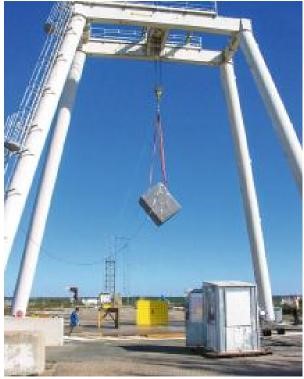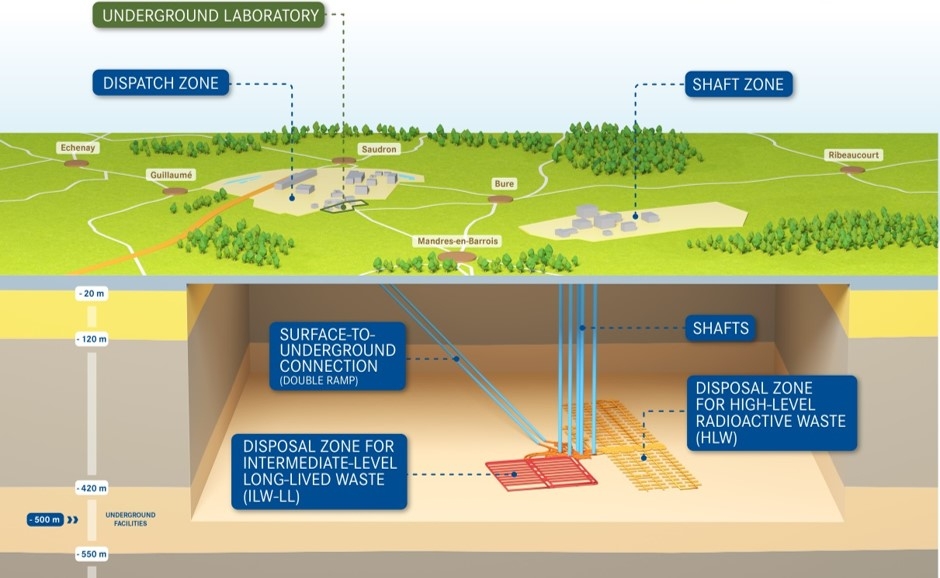Safety at the heart of the Cigéo project
Protecting people and the environment from the dangers posed by the most radioactive waste is a requirement that applies to every phase of the project, from design to operation, and extends beyond closure, for hundreds of thousands of years.

Like any industrial facility, particularly a nuclear one, the construction of Cigéo involves risks that may arise during its construction, operation and, in the specific case of geological disposal, after its closure. The aim of the safety demonstration is to establish the disposal's ability to control these risks, thanks in particular to the design, operating and closure measures taken by Andra. For example, during the operating phase, risks may be associated with waste handling and disposal operations. These operations must also take into account the specific characteristics of an underground facility. After closure, the safety of Cigéo must be ensured passively, without human intervention and over a very long period, relying above all on the qualities of the geological layer.
The safety demonstration is the result of more than 30 years of studies and research, regularly assessed since 2005 by the French Nuclear Safety Authority, its technical support body the Institut de Radioprotection et de Sûreté Nucléaire (IRSN) and international experts. "We are now providing proof that we have the capacity to carry out the entire installation, at every stage, with a complete demonstration of safety", emphasises Sébastien Crombez, Director of Safety, Environment and Strategy at Andra.
The risk analyses cover the entire operational life of Cigéo and after its closure. Analysis of the scenarios studied shows that the impact of Cigéo on man and his environment would remain very limited. "For these scenarios, we have adopted a logic of humility: we envisage even unlikely situations and imagine that we have made mistakes. We also look at cascades of events to test the performance of redundant defence systems. What happens if there is a fire and the extinguishing systems fail? What happens in the event of a seal failure and leakage of high-level waste packages? In the event of an intruder? What if there is a fracture in the geological layer that we have not detected? In all these scenarios, the impact remains low. Whatever the failures, the system remains robust," explains Sébastien Crombez.
During the operational phase: protecting staff, local residents and the environment
The demonstration of safety in operation is based on a detailed analysis of the various risks likely to occur, particularly during package reception and disposal operations. Examples include the risk of fire and falling packages, as well as natural hazards and hazards outside Cigéo, such as flooding and falling aircraft.
On the basis of this risk analysis, the safety approach consists of planning, right from the design stage, protective measures for the installation and the organisation of the disposal operation. The aim is to ensure that a response is provided to each risk identified, in order to avoid it and/or limit its effects.
The safety approach is based on the principle of defence in depth, which involves putting in place several lines of defence against the same risk, i.e. multiple protective measures that are independent of each other.
In practical terms, this means
- firstly, to prevent the occurrence of an incident or accident (fall of a package, fire, flood, etc.) through the design and operating methods of Cigéo ;
- secondly, to implement the means of detecting malfunctions and the means of intervention to maintain the facility in safe conditions.
In a cautious approach, despite all these measures, which make the occurrence of a malfunction highly unlikely, Andra nevertheless considers that incidents or accidents may occur. It implements measures to minimise their consequences and assesses their impact to ensure that they remain acceptable.

After closure: the central role of geology
The long-term passive safety of Cigéo is based on the closure of the underground facility and the ability of the host geological layer to contain and limit the migration of radioactivity to the surface. The purpose of assessing safety after closure is to demonstrate that the geological layer does indeed play this protective role over time.
The post-closure risks that are taken into account in the long term include possible disturbances to the geological layer due to the presence of the disposal (e.g. damage to the rock in the vicinity of the disposal during excavation of the underground structures), natural events (e.g. an earthquake), failure of the disposal packages or closure systems (e.g. failure of all the sealing systems for the underground structures, particularly the shafts and drifts), failure of the host layer (e.g. an undetected fracture) or unintentional human activity (e.g. drilling) if the disposal is forgotten.
On the basis of the risk analysis and the scientific and technological knowledge acquired at this stage of the studies, Andra has assessed the way in which the radioactivity contained in the waste is likely to reach the surface, and in fact reach humans. The aim is to verify the capacity of the disposal and the geological environment to guarantee the protection of man and the environment over the long term, in normal operation and in the event of malfunctions. This is achieved by developing a normal development scenario, which represents the expected development of the disposal over time and space, and scenarios that allow the consequences of potential malfunctions or unintentional human intrusion through boreholes to be studied, thereby deviating from the expected development of the disposal.
Ultimately, whatever the scenario envisaged, the impact on man and the environment remains below the limits set by the French safety Authority ASN.

WHAT IS THE RADIOLOGICAL IMPACT?
During normal operation, the maximum radiological impact of Cigéo on local populations is estimated at 0.001 mSv/year, 1,000 times lower than the limit set by regulations for any nuclear activity (1 mSv/year). After closure, the maximum radiological impact of Cigéo in normal operation would only occur after several hundred thousand years, and would be of the order of 0.0015 mSv/year, well below the reference value of 0.25 mSv/year estimated by the ASN in the safety guide for geological disposal.

